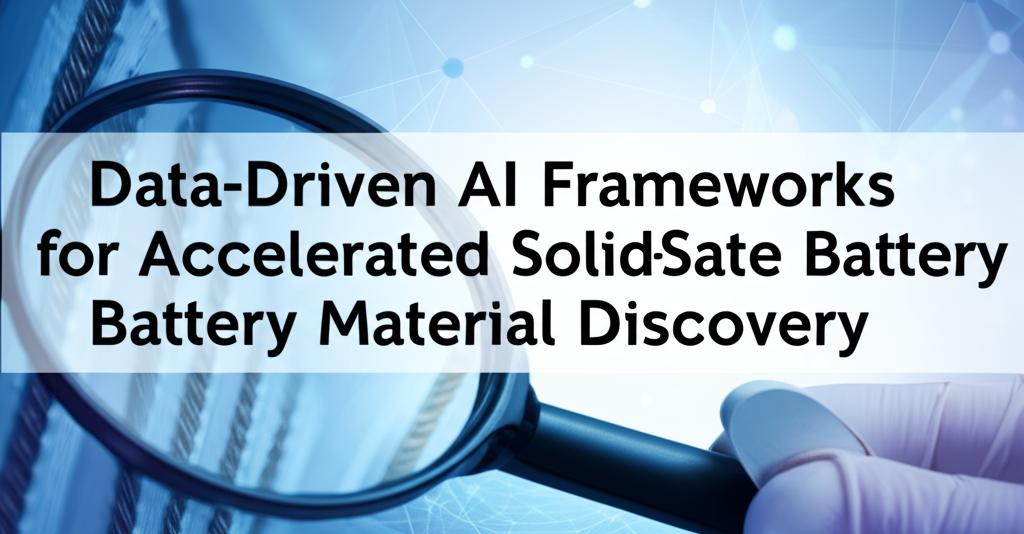The quest for safer, more potent, and longer-lasting energy storage is increasingly turning to solid-state batteries (SSBs). However, discovering the ideal materials for these next-generation power sources is a complex and traditionally time-consuming endeavor. Data-driven artificial intelligence (AI) frameworks are emerging as a transformative solution, significantly accelerating the identification and optimization of novel solid-state electrolytes (SSEs) and electrode materials.
The Challenge of Traditional DiscoveryConventional methods for finding suitable SSE materials rely heavily on trial-and-error, a labor-intensive and often inefficient process. Researchers typically test individual materials and synthesis pathways sequentially, which can take years to yield promising candidates. This slow pace is a major bottleneck in advancing SSB technology to meet the urgent demands of electric vehicles, portable electronics, and grid-scale energy storage. Furthermore, the sheer number of potential chemical combinations for battery materials is vast, making exhaustive experimental exploration impractical.
AI-Powered AccelerationData-driven AI frameworks offer a paradigm shift by leveraging machine learning (ML), deep learning, and high-throughput computational screening. These frameworks can:
- Rapidly Screen Vast Material Landscapes: AI algorithms can sift through enormous databases of known and theoretical materials, including their structural, physical, chemical, electronic, and thermodynamic properties. For instance, AI has been used to screen millions of potential inorganic materials for battery applications in a matter of hours, a task that would take decades using traditional methods.
- Predict Material Properties and Performance: By training on existing experimental and computational data, AI models can predict crucial properties of new candidate materials. This includes ionic conductivity, electrochemical stability, phase stability, and interfacial behavior – all critical for high-performance SSBs. Some models can even forecast reaction pathways and explain why a particular candidate is promising, providing researchers with valuable insights before lab experiments begin.
- Optimize Material Synthesis and Design: AI can analyze parameters in material preparation processes, such as temperature and pressure, to enhance production consistency and reduce manufacturing costs. This is particularly important for solid-state electrolytes, where microstructure plays a critical role.
- Identify Novel Ion Migration Mechanisms: AI, in conjunction with computational techniques like ab initio metadynamics (MetaD), can help uncover complex ion migration mechanisms within SSEs. For example, novel "two-step" ion migration mechanisms have been identified in hydride SSEs using such approaches.
- Integrate Diverse Data Sources: Modern AI frameworks can combine data from various sources, including large language models (LLMs) that process information from scientific literature, computational simulations (like Density Functional Theory and Molecular Dynamics), and experimental results. This holistic approach allows for more robust and accurate predictions.
Several key technologies and methodologies underpin these advanced frameworks:
- Machine Learning Algorithms: Techniques like logistic regression, random forests, and gradient boosting algorithms (e.g., XGBoost) are used for tasks such as predicting material properties and screening candidates.
- Large Quantitative Models (LQMs) and Large Language Models (LLMs): LQMs can simulate chemical interactions and molecular properties to generate vast datasets for training AI models. LLMs help extract and process knowledge from existing scientific literature.
- High-Throughput Computational Screening: This involves using computational tools to rapidly evaluate the properties of many materials in silico.
- Databases and Data Mining: Comprehensive databases of material properties are essential. Researchers are developing specialized databases, such as the Dynamic Database of Solid-State Electrolyte (DDSE), to support AI-driven discovery.
- Theory-Experiment Benchmarking: AI frameworks often include a feedback loop where theoretical predictions are validated through experiments, and the experimental results are then used to further refine the AI models.
- Genetic Algorithms and Swarm Intelligence: These optimization techniques can be used to search for optimal crystal structures or compositions.
Recent research highlights the power of these integrated approaches. Scientists at Tohoku University, for example, have developed a data-driven AI framework that combines LLMs, MetaD, multiple linear regression, genetic algorithms, and theory-experiment benchmarking to identify and optimize SSE candidates. This model not only selects optimal materials but also predicts reaction pathways and underlying mechanisms.
Collaborations, such as the one between Microsoft and the Pacific Northwest National Laboratory (PNNL), have demonstrated the ability of AI to dramatically reduce the time needed to identify promising new battery materials. Their work led to the discovery of a novel solid-state electrolyte candidate by screening over 32 million potential materials in just 80 hours.
Looking ahead, the integration of generative AI tools holds the potential to further enhance the predictive capabilities of these frameworks, allowing for the exploration of novel ion migration pathways and reaction mechanisms. The continued development and application of AI-driven materials discovery are poised to overcome longstanding challenges in SSB research, paving the way for a new era of high-performance, sustainable energy storage solutions. The focus remains on improving key performance indicators such as energy density, cycle life, safety, and cost, while also considering the environmental impact of materials and manufacturing processes.

